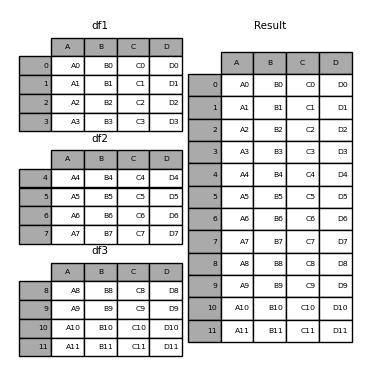Columns Overlap But No Suffix Specified
Columns overlap refers to a situation in which two or more columns in a dataset share the same name but have different data. This can occur when merging or joining datasets, especially when the columns being merged have the same name. The absence of a suffix in columns overlap refers to the lack of a clear indication or distinction between the overlapping columns, making it difficult to identify and analyze the data accurately.
II. The impact of columns overlap on data analysis
Columns overlap can have a significant impact on data analysis, as it can lead to confusion and inaccurate results. When overlapping columns are not clearly differentiated, it becomes challenging to determine which data corresponds to which column. This can result in errors, misinterpretations, and biased analysis.
Furthermore, columns overlap can affect statistical calculations and modeling techniques. With overlapping columns, it becomes unclear which data should be used for specific calculations or which column should be considered as the “correct” representation of the data. This can lead to incorrect statistical inferences and flawed decision-making.
III. Strategies for identifying columns overlap in a dataset
To identify columns overlap in a dataset, several strategies can be employed:
1. Manual inspection: Carefully reviewing the dataset and comparing column names can help identify any overlapping columns. This method may work well for smaller datasets but can be time-consuming and prone to errors in larger datasets.
2. Using data analysis libraries: Tools like Pandas offer functions that can check for overlapping columns and highlight any duplicates. For example, the `duplicated()` function in Pandas can identify duplicated column names.
3. Exploratory data analysis (EDA): EDA techniques, such as summary statistics, histograms, or scatterplots, can help identify patterns or inconsistencies in the data that might suggest columns overlap.
IV. Potential causes of columns overlap in datasets
Several factors can contribute to columns overlap in datasets:
1. Merging or joining datasets: When merging or joining datasets, it is common to encounter columns with the same name. If there is no clear indication or a suffix specified in the merged dataset, overlapping columns can occur.
2. Data extraction or loading issues: In some cases, data extraction or loading processes may inadvertently introduce duplicate columns due to human error or technical glitches.
3. Data transformation or preprocessing: During data transformation or preprocessing steps, such as data cleaning or feature engineering, columns may be duplicated or renamed without proper handling, leading to overlapping columns.
V. Dealing with columns overlap: fixing and correcting the issue
When encountering columns overlap, several steps can be taken to address the issue:
1. Renaming columns: To avoid ambiguity, overlapping columns can be renamed with unique names that reflect their content or source. This can be done manually or by using functions like `rename` in Pandas.
2. Dropping columns: If the overlapping columns are redundant or irrelevant for the analysis, they can be dropped from the dataset using functions like `drop` in Pandas.
3. Merging or replacing columns: If the overlapping columns contain important information, they can be merged or replaced into a single column to ensure no duplicate or contradictory data exists. This can be achieved using functions like `merge`, `join`, or `concatenate` in Pandas.
VI. Preventing columns overlap in future datasets
To prevent columns overlap in future datasets, the following practices can be followed:
1. Establish clear naming conventions: Implementing consistent and descriptive naming conventions for columns can minimize the chances of overlap. Using prefixes or suffixes to indicate the source or context of each column can be helpful.
2. Standardize data transformation processes: Ensuring standardized procedures for data transformation, cleaning, and preprocessing can help prevent accidental duplication or misnaming of columns.
3. Double-check merging or joining procedures: When merging or joining datasets, it is crucial to carefully specify the merging columns and ensure no duplicate columns are introduced. Providing a clear suffix when merging columns can also help avoid overlap.
VII. The importance of clean and accurate data for effective analysis and decision-making
Clean and accurate data is crucial for effective analysis and decision-making. Inaccurate or overlapping columns can lead to biased conclusions, misinterpretations, and flawed decision-making. It is essential to invest time and effort into ensuring data integrity, including addressing columns overlap and properly managing data merging or transformation processes.
By employing the strategies mentioned above, such as identifying and fixing columns overlap and implementing preventative measures, analysts and data scientists can ensure their datasets are reliable, enabling them to draw accurate insights and make informed decisions.
FAQs
Q: How can I identify columns overlap in a dataset using Python?
A: Using libraries like Pandas, you can utilize functions like `duplicated()` or visually inspect the column names to identify overlapping columns.
Q: What should I do if I have overlapping columns in my dataset?
A: If the overlapping columns are redundant or irrelevant, you can drop them. If they contain important information, you can merge or replace them into a single column using functions like `merge` or `join` in Pandas.
Q: How can I prevent columns overlap in future datasets?
A: Establishing clear naming conventions, standardizing data transformation processes, and double-checking merging procedures can help prevent columns overlap in future datasets.
Q: Why is it important to have clean and accurate data?
A: Clean and accurate data is vital for unbiased analysis and confident decision-making. Inaccurate or overlapping columns can lead to errors, misinterpretations, and ultimately, flawed conclusions.
Python : Pandas Join Issue: Columns Overlap But No Suffix Specified
Keywords searched by users: columns overlap but no suffix specified Dataframe merge overlapping columns, Pandas merge replace existing columns, Pandas join, Drop column pandas, Pandas merge on multiple columns, Merge column pandas, Prevent duplicate columns when joining two dataframes, Rename column pandas
Categories: Top 71 Columns Overlap But No Suffix Specified
See more here: nhanvietluanvan.com
Dataframe Merge Overlapping Columns
Dataframes are powerful data structures in Python that allow users to efficiently manipulate and analyze data. In many cases, we need to merge or combine multiple dataframes to create a single, comprehensive dataset. However, when merging dataframes, we often encounter overlapping columns that need to be resolved. In this article, we will explore various methods to handle overlapping columns in a dataframe merge.
Understanding Dataframe Merge:
Before diving into overlapping columns, let’s start by understanding the basics of dataframe merge. The merge operation combines two or more dataframes based on common columns or indices. It allows us to combine data from different data sources that share common information.
In Python, Pandas library provides a versatile merge() function that performs different types of merges, including inner, outer, left, and right joins. These different join types determine the resulting dataframe and how the merging is performed.
Overlapping Columns in DataFrame Merge:
When merging dataframes, we might encounter overlapping columns. Overlapping columns occur when two or more dataframes being merged have columns with the same name. This situation creates ambiguity, and we need to resolve it to avoid conflicts in the final dataset. Failure to handle overlapping columns correctly can result in incorrect or unexpected data.
Methods to Merge Overlapping Columns:
There are several ways to handle overlapping columns during the merge operation. Let’s explore some common methods:
1. Renaming Columns:
One straightforward approach is to rename the overlapping columns before merging. By giving them unique names, we can avoid conflicts. Pandas provides a rename() function that can be used to rename specific columns.
2. Selecting Columns:
Another method is to select only the necessary columns from each dataframe, excluding the overlapping ones. This way, we can avoid merging them and eliminate any conflicts. The drop() function in Pandas can aid in dropping unwanted columns.
3. Addressing Conflicts:
If we want to merge the overlapping columns, we need to handle the conflicts. This can be done in a few different ways:
– Overwriting: We can choose to overwrite the values in the overlapping columns. By using the merge() function, specifying the suffixes parameter allows us to differentiate the columns.
– Aggregation: In some cases, it might be necessary to aggregate the values from overlapping columns. We can use functions like sum(), mean(), or concatenation to combine the values. The groupby() function in Pandas can be helpful in performing aggregations.
– Priority: Assigning priority to one dataframe’s columns over another can also be an option. We can select which value to keep based on the source dataframes or certain conditions.
– Dropping Duplicate Columns: If the overlapping columns contain redundant information, dropping duplicate columns might be the best approach to maintain a clean and concise dataset.
FAQs:
Q: Why do overlapping columns occur during dataframe merge?
A: Overlapping columns occur when two or more dataframes being merged have columns with identical names. It can happen due to the nature of the data or the merging process itself.
Q: Can we merge dataframes without resolving overlapping columns?
A: Technically, we can merge dataframes without resolving overlapping columns, but it might result in conflicts, unexpected behavior, or incorrect data. Therefore, it is recommended to handle overlapping columns appropriately.
Q: Which merge method should be used to handle overlapping columns?
A: The choice of merge method depends on the specific scenario and the desired outcome. Renaming columns, selecting specific columns, addressing conflicts, or dropping duplicates are some commonly used methods.
Q: How can we rename overlapping columns?
A: We can use the Pandas rename() function to rename overlapping columns. By giving unique names to these columns, we can avoid conflicts during the merge operation.
Q: Can we combine the values from overlapping columns using a specific function?
A: Yes, we can use aggregation functions like sum(), mean(), or concatenation to combine values from overlapping columns. The choice of function depends on the nature of the data and the desired outcome.
In conclusion, merging dataframes with overlapping columns is a common scenario in data manipulation. To handle such situations, we can rename columns, select specific columns, address conflicts, or drop duplicates. Choosing the right method depends on the specific needs and desired outcome of the merge operation. Be cautious while merging dataframes with overlapping columns, as incorrect handling can lead to unexpected results.
Pandas Merge Replace Existing Columns
When working with large datasets, merging data from different sources is a frequent task. Pandas, a popular data analysis and manipulation library in Python, provides an incredibly powerful tool called “merge” that helps combine data from multiple sources into a single dataset. In this article, we will explore the Pandas merge function, with a specific focus on how to replace existing columns during the merge process.
Understanding the Pandas Merge Function:
The Pandas merge function allows us to combine two or more DataFrames based on a common column. It is similar to the JOIN operation in SQL. By default, the merge function performs an inner join, meaning that only the matching rows in both DataFrames will be included in the merged result.
Syntax:
The basic syntax for merging DataFrames using the merge function is as follows:
merged_dataframe = pd.merge(left_dataframe, right_dataframe, on=’common_column’)
Replace Existing Columns:
Sometimes, during a merge operation, we may encounter scenarios where the same column name appears in both the left and right DataFrames. By default, the merge function appends a suffix (_x or _y) to the column name to avoid ambiguity in the merged result. However, in some cases, we may want to replace the existing columns in one DataFrame with those from another DataFrame. Pandas merge allows us to achieve this through the suffixes parameter.
To replace existing columns in the left DataFrame, we can pass a list of suffixes as a tuple of strings to the suffixes parameter. The first element of the tuple will replace the suffix of the left DataFrame column, while the second element replaces the suffix of the right DataFrame column.
Let’s consider an example to understand how this works:
“` python
import pandas as pd
left_dataframe = pd.DataFrame({‘id’: [1, 2, 3],
‘name’: [‘John’, ‘Alice’, ‘Bob’],
‘age’: [25, 30, 35]})
right_dataframe = pd.DataFrame({‘id’: [2, 3, 4],
‘name’: [‘Alex’, ‘Emma’, ‘Charlie’],
‘age’: [28, 26, 40]})
merged_dataframe = pd.merge(left_dataframe, right_dataframe, on=’id’, suffixes=(‘_left’, ‘_right’))
“`
In this example, we have two DataFrames, left_dataframe and right_dataframe, that share a common column, ‘id’. The merge operation combines the two DataFrames based on this column. By specifying suffixes=(‘_left’, ‘_right’), the merged_dataframe will replace the existing columns ‘name’ and ‘age’ from the left_dataframe with ‘name_left’ and ‘age_left’, respectively. The columns from the right_dataframe, including ‘name’ and ‘age’, will remain unchanged.
FAQs:
Q: What happens if both DataFrames have different column names that need to be replaced during the merge?
A: In this case, we can use the suffixes parameter to specify the desired suffixes for the left and right DataFrames. For example, suffixes=(‘_l’, ‘_r’) will append ‘_l’ to the columns from the left DataFrame and ‘_r’ to the columns from the right DataFrame.
Q: Is it possible to merge DataFrames without considering a common column?
A: Yes, Pandas merge has a different syntax that allows merging on an index or merging without a common column. By using the ‘left_index’ and ‘right_index’ parameters instead of ‘on’, we can merge DataFrames based on their indices.
Q: Can we replace existing columns from both DataFrames simultaneously during a merge?
A: Yes, by providing different suffixes for the left and right DataFrames, we can replace columns from both DataFrames during the merge operation.
Q: Can the same column be used for merging in case there are duplicates in the common column?
A: Yes, Pandas merge handles duplicates in the common column by performing a one-to-many merge. It includes all possible matches in the merged result.
Conclusion:
The Pandas merge function provides a powerful tool for combining data from different sources, such as multiple DataFrames. By default, it appends suffixes to the column names to avoid ambiguity in the merged result. However, if we want to replace existing columns during the merge, the suffixes parameter allows us to achieve this. Understanding how to replace existing columns during a merge operation is crucial for accurately combining datasets and maintaining data integrity.
Pandas Join
Pandas, the popular open-source data analysis and manipulation library for Python, offers a range of powerful functions for working with structured data. One of the most important features provided by Pandas is the ability to combine, merge, and join different datasets. In this article, we will dive deep into Pandas join operation, exploring its functionality, various types of joins, performance considerations, and common usage scenarios.
Understanding the Basics: What is a Join Operation?
In the context of data analysis, a join operation is the process of combining two or more datasets based on a common attribute or key. This attribute is used to match the rows from different datasets, and the resulting output contains a combination of columns from all the joined datasets. Pandas join allows us to combine data based on common column values, offering us unparalleled flexibility and control over the merge process.
Types of Joins in Pandas
Pandas provides several types of joins, each serving a specific purpose. Let’s take a closer look at the most commonly used join types:
1. Inner Join: The default join in Pandas is the inner join. It only includes the rows with matching values from both datasets, discarding the non-matching ones. This type of join is useful when we are interested in the intersection of two datasets, limiting our output to only the relevant information.
2. Left Join: A left join includes all the records from the left dataset (called the left table) and the matching records from the right dataset (called the right table). Any non-matching entries from the right table will contain missing or NaN values in the resulting joined dataset.
3. Right Join: A right join is the opposite of a left join, including all the records from the right table and the matching records from the left table. Non-matching entries from the left table will have missing or NaN values in the joined dataset.
4. Outer Join: An outer join combines all the rows from both datasets, including both the matching and non-matching entries. The resulting joined dataset will contain NaN values in the non-matching areas.
Performing a Join Operation in Pandas
To perform a join operation in Pandas, we use the `pd.merge()` function. This function takes the left and right datasets as input, along with the column(s) to join on, and the type of join to apply.
Here’s an example of joining two datasets on a common “key” column using the inner join:
“`python
import pandas as pd
left_df = pd.DataFrame({‘key’: [‘A’, ‘B’, ‘C’], ‘value’: [1, 2, 3]})
right_df = pd.DataFrame({‘key’: [‘B’, ‘C’, ‘D’], ‘value’: [4, 5, 6]})
merged_df = pd.merge(left_df, right_df, on=’key’)
“`
In this example, `left_df` and `right_df` are the left and right datasets, respectively. By specifying `on=’key’`, we instruct Pandas to join the datasets based on the “key” column. The resulting `merged_df` will contain only the rows where the “key” values are common between the two datasets.
Performance Considerations
When working with large datasets, the performance of join operations becomes a crucial aspect. Pandas offers several optimizations to enhance join performance. These include using appropriate join types, indexing the join columns, and using efficient algorithms under the hood.
Frequently Asked Questions (FAQs)
Q1: Can I join more than two datasets in Pandas?
A1: Yes, you can join multiple datasets in Pandas by chaining the `pd.merge()` function. For example, you can join three datasets A, B, and C by using `pd.merge(pd.merge(A, B, on=’key’), C, on=’key’)`.
Q2: What happens if I don’t specify the `on` parameter in `pd.merge()`?
A2: If you don’t specify the `on` parameter, Pandas will automatically perform a join operation based on the common column names in both datasets.
Q3: How do I handle non-matching entries during a join?
A3: Pandas by default handles non-matching entries by setting those values as NaN in the resulting joined dataset. You can use the `how` parameter in `pd.merge()` to choose how non-matching entries should be handled (e.g., `how=’inner’`, `how=’left’`, etc.).
Q4: Can I join datasets based on multiple columns?
A4: Yes, you can join datasets on multiple columns by passing a list of column names to the `on` parameter in `pd.merge()`.
Conclusion
Pandas join operations provide an efficient and flexible way to integrate, combine, and analyze structured data. Understanding the different join types and their respective use cases is essential for effective data manipulation and exploration. By mastering the art of joining datasets using Pandas, you can unleash the full potential of your data analysis workflows and unlock valuable insights.
Images related to the topic columns overlap but no suffix specified

Found 44 images related to columns overlap but no suffix specified theme

![python - ValueError: columns overlap but no suffix specified: Index(['Adj. Close'], dtype='object') - Stack Overflow Python - Valueerror: Columns Overlap But No Suffix Specified: Index(['Adj. Close'], Dtype='Object') - Stack Overflow](https://i.stack.imgur.com/zh3bI.png)
![Valueerror: columns overlap but no suffix specified: [SOLVED] Valueerror: Columns Overlap But No Suffix Specified: [Solved]](https://itsourcecode.com/wp-content/uploads/2023/06/valueerror-columns-overlap-but-no-suffix-specified.png)
![python - ValueError: columns overlap but no suffix specified: Index(['Adj. Close'], dtype='object') - Stack Overflow Python - Valueerror: Columns Overlap But No Suffix Specified: Index(['Adj. Close'], Dtype='Object') - Stack Overflow](https://i.stack.imgur.com/eF3sl.png)



![python - ValueError: columns overlap but no suffix specified: Index(['Adj. Close'], dtype='object') - Stack Overflow Python - Valueerror: Columns Overlap But No Suffix Specified: Index(['Adj. Close'], Dtype='Object') - Stack Overflow](https://i.stack.imgur.com/RMnFN.png)
![pandas] ValueError: columns overlap but no suffix specified: – Cumulative Sum Pandas] Valueerror: Columns Overlap But No Suffix Specified: – Cumulative Sum](https://cumsum.files.wordpress.com/2019/12/wp-1576905054506.jpg?w=240)













![Valueerror: columns overlap but no suffix specified: [SOLVED] Valueerror: Columns Overlap But No Suffix Specified: [Solved]](https://itsourcecode.com/wp-content/uploads/2021/01/IT-SOURCECODE_ICON-07.jpg)


Article link: columns overlap but no suffix specified.
Learn more about the topic columns overlap but no suffix specified.
- Pandas join issue: columns overlap but no suffix specified
- How to Fix: columns overlap but no suffix specified – Statology
- How to Fix: columns overlap but no suffix specified
- ValueError: columns overlap but no suffix specified [Solved]
- Columns Overlap but No Suffix Specified: Debug the Error in …
- Solve “columns overlap but no suffix specified” in Pandas
- Valueerror: columns overlap but no suffix specified: [SOLVED]
- Pandas join issue: columns overlap but no suffix specified …
- Valueerror: Columns Overlap But No Suffix Specified (Resolved)
- [pandas] ValueError: columns overlap but no suffix specified
See more: nhanvietluanvan.com/luat-hoc